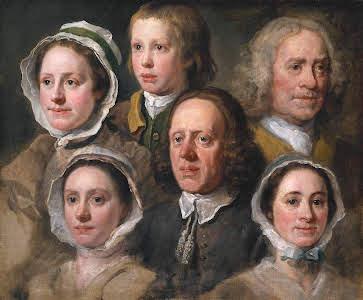Going by Coach
"Though Lydia's short letter to Mrs F gave them to understand that they were going to Gretna Green, something was dropped by Denny expressing his belief that W never intended to go there, or to marry Lydia at all, which was repeated to Colonel F, who, instantly taking the alarm, set off from B intending to trace their route. He did trace them easily to Clapham, but no farther; for on entering that place they removed into a hackney-coach and dismissed the chaise that brought them from Epsom. All that is known after this is that they were seen to continue the London road."
Pride and Prejudice
 The hackney coach derives its name from the French word "haquenee" meaning 'horse for hire'. The Hackney Coach or hackney cab first came to London proper in 1625 when there were twenty of them available for hire at inns. The first hackney coaches were a one-horse chaise for hire consisting of a primitive springless box upon wheels pulled by a single horse riden by the driver. Later Hackney coaches were often the discarded and outdated coaches of the nobility, often still bearing their faded coats of arms.
The hackney coach derives its name from the French word "haquenee" meaning 'horse for hire'. The Hackney Coach or hackney cab first came to London proper in 1625 when there were twenty of them available for hire at inns. The first hackney coaches were a one-horse chaise for hire consisting of a primitive springless box upon wheels pulled by a single horse riden by the driver. Later Hackney coaches were often the discarded and outdated coaches of the nobility, often still bearing their faded coats of arms.
The hackney coaches were shabby with dirty interiors. They operated out of inn yards and from coach stands located near main streets.  The watermen, who plied boats on the Thames, felt their trade threatened by the introduction of the hackney coach, followed by the sedan chair in 1634. The Waterman's Company succeeded in keeping hackney coaches out of London for many years (unless their journeys ended at least two miles from the river). However by the Reign of Charles II, hackney coaches had become firmly established in London.
The watermen, who plied boats on the Thames, felt their trade threatened by the introduction of the hackney coach, followed by the sedan chair in 1634. The Waterman's Company succeeded in keeping hackney coaches out of London for many years (unless their journeys ended at least two miles from the river). However by the Reign of Charles II, hackney coaches had become firmly established in London.
A compromise was reached that employed watermen, the thirst of the hackney coach horse was slacked by licensed watermen, whose job it was to carry buckets of water to the horses. The waterman dressed in a jaunty coloured neckcloth, leather apron, rug coat, and sheepskin hat and gaiters. He wore the number of his coachstand license on a brass plaque around his neck. The waterman was portrayed by William Pyne in "The Costume of Great Britain."
Captain Bailey a retired mariner established a rank for six hackney coaches at the Maypole in the Strand London in 1643. This was the first coach stand in the street. Bailey established a fare schedule for trips to different parts of London, and dressed his drivers in livery so that they would be easily recognisable to customers. The hackney coachman wore a box coat or a caped great coat usually blue, but varying with his company, knee breeches, and a low crowned hat. A hackney-coach driver is referred to as a Jarvey.
The coachmen set their horses in motion with the call gee-o, and Ge-o’ is a contraction of Geoffrey as is Jarvey. In the eighteenth century "set down" was a hackney coach term meaning to unload passengers at the completion of a trip. Gradually "set down" came to mean the trip itself. "For sixpence one may have a set down, as it is called, of a mile and a half..." from the 1739 edition of Joe Miller's Jests.
Hackney Coaches were subject to laws and regulations under the direction of the lords of his majesty's treasury. Each coach was licensed and designated with a numbered plate. In 1662 only 400 licenses were granted, in 1694 the number was increased to 700 and, in 1771 to 1000. By 1823 there were 1,200 plated and numbered hackney coaches in London. Everything from fare rates to the coachman's behaviour was strictly regulated. Regulations included a minimum size for the coach horse: "No horse shall be used with a hackney-coach, or chariot, which shall be under 14 hands high."
Queen Anne found the chair men and hackney coachmen so foul in their language that she felt it necessary to mandated that "the drivers of coaches, and carriers of chairs, on demanding more than their fare, or giving abusive language, are to forfeit not more than 5 shillings and in default of the payment, they are to be sent to the house of correction seven days." George I added laws against extortion: "coachmen refusing to go on, or extorting more than their fare, are to forfeit not more than 3 Guineas not less than 10s. Not only commissioners, but also justices, may determine offences, and inflict punishments."
 In 1823, a hackney 'cabriolet', built by David Davies (a coachbuilder of Albany Street, London) was licensed for public conveyance in England. The term Cab comes from cabriolet, a word borrowed into English from French in the 18th century, designating a "two-wheeled coach drawn by a single horse with the driver perched on a seat at the rear. "
In 1823, a hackney 'cabriolet', built by David Davies (a coachbuilder of Albany Street, London) was licensed for public conveyance in England. The term Cab comes from cabriolet, a word borrowed into English from French in the 18th century, designating a "two-wheeled coach drawn by a single horse with the driver perched on a seat at the rear. "
These cabs stood for hire in Portland Street. They were painted yellow, and numbered twelve in all. Private equipages ranged from the simple curate cart to elegant coaches , just as modern cars range from the Mini to limousines. A private coach was expensive to maintain in London. One of Beau Brummel's economies was to do without a coach.
Owning a coach required the stabling and feeding of horses and additional servants to care for the coach and horses and drive the coach. The coachman drove the coach. He had to be an expert at negotiating the London traffic. The coachman was also head of the stables. The grooms and stable boys were in his charge. A truly well turned out coach required footmen riding at the back of the equipage. The sporty curricle had a small seat behind for a tiger who would walk the horses while the gentleman paid a call. Townhouses often had stables that opened onto an alley behind the residence. The stable served as housing for the horses and as a storage place for the carriage and harness. The coachman, grooms, and stable boys slept in rooms in the upper story of the stable.
Carriages of the wealthy were elegant equipages with rich silk damask fabrics upholstering the seats and beautifully painted and gilded crests embellishing the doors. Accessories might include pistols stored in a secret compartment, wine or other spirits stored in a special compartment under the seat, a beautifully made carriage clock, and rich fur lap robes. To safe-guard possessions and the horses a dalmatian dog was used as a guard. The dogs were also valued as a living ornament to the coach as well as a "car alarm".
 For long trips such as the return to their country estates, rooms would be booked in advance and the nobleman's own horses placed along the way to assure a good team for changes of horses. The nobility often carried their own bedding and towels with them for fear of lice and fleas at inns. The horses that pulled the coach were specially bred carriage horses. They were referred to as warmbloods because the horses were the result of breeding (hot blooded) Arabian stallions with native English horses. The Yorkshire Coach Horse with its unmatched ability for speed, style, and power was a favorite breed for carriage use . This breed was the result of breeding a Thoroughbred race horse with Cleveland Bay carriage horses. As you might imagine, the animals represented a substantial investment.
For long trips such as the return to their country estates, rooms would be booked in advance and the nobleman's own horses placed along the way to assure a good team for changes of horses. The nobility often carried their own bedding and towels with them for fear of lice and fleas at inns. The horses that pulled the coach were specially bred carriage horses. They were referred to as warmbloods because the horses were the result of breeding (hot blooded) Arabian stallions with native English horses. The Yorkshire Coach Horse with its unmatched ability for speed, style, and power was a favorite breed for carriage use . This breed was the result of breeding a Thoroughbred race horse with Cleveland Bay carriage horses. As you might imagine, the animals represented a substantial investment.
Reprinted with persmission Sharon Wagoner, Curator of The Georgian Index. Visit this site for a historical tour through Regency London!



Leave a comment
This site is protected by hCaptcha and the hCaptcha Privacy Policy and Terms of Service apply.